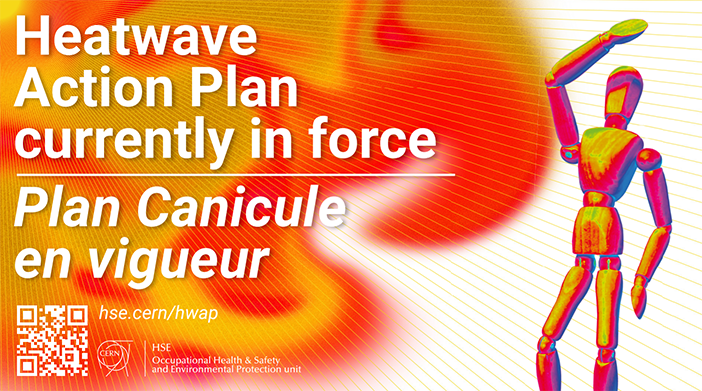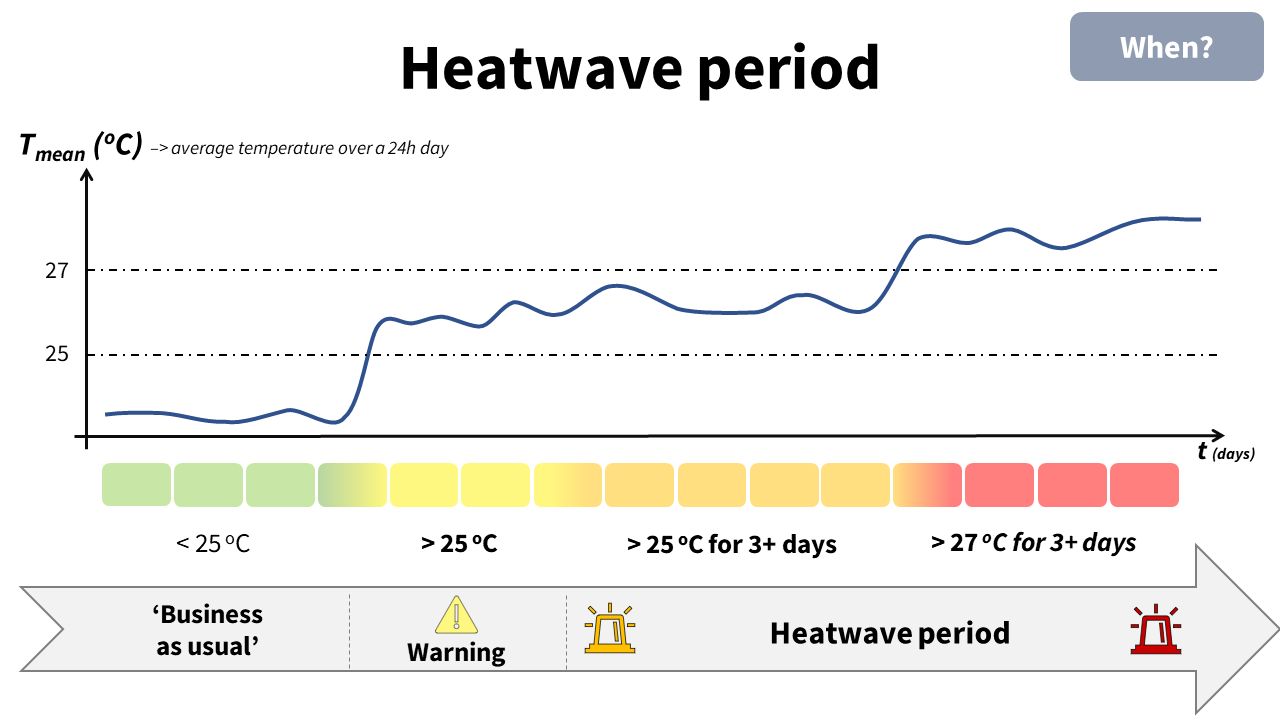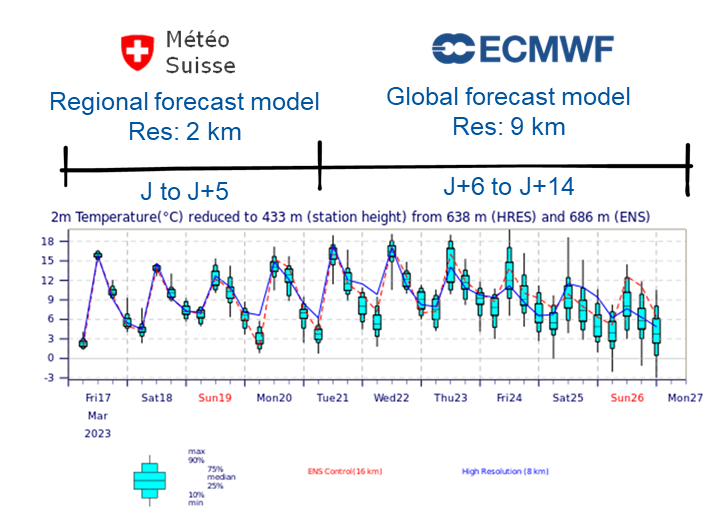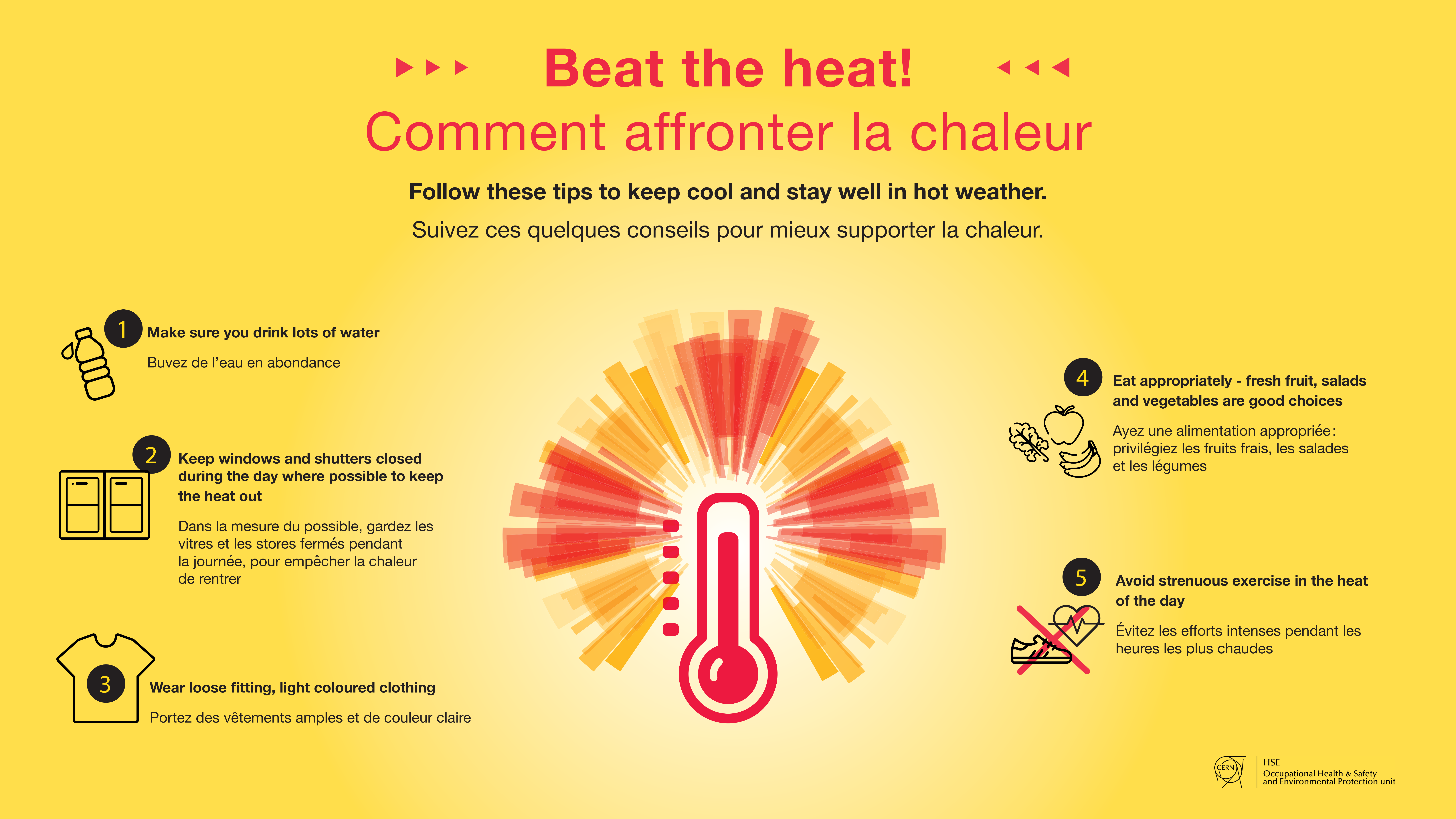Heatwave Action Plan
On this page:
Introduction | HWAP Activation and community info
HWAP measures in detail (Individuals, Supervisors, Fire Hazard, Administrative Measures, Technical Measures)
FAQ | Beating the heat: symptoms and tips | Scientific basis and heatwave criteria Situation 2022 - 2024
The heatwave action plan is NOT currently in force. The last heatwave period ended on 17 August at 8 p.m.
Weather forecast
* Average temperature over the course of 24h, taking into account temperatures over night as well.
¹Weather data by MeteoSuisse.admin.ch²Weather data by Open-Meteo.com
Introduction
With heatwaves becoming more common in Switzerland, CERN’s Enlarged Directorate approved a dedicated Heatwave Action Plan (HWAP) in 2023, with individual, organisational and technical measures to protect CERN personnel from the health impacts of heatwaves.
This series of measures is inspired by best practices used in the Host States (see scientific basis) and aims to minimise the risks to health and safety at work due to heatwave conditions.
IMPORTANT NOTE: the Heatwave Action Plan will only be activated by the HSE unit upon official notification by MétéoSwiss,based on their official criteria for declaration of heatwaves. Where a daily average temperature 25oC or more, sustained over a period of 3 days is reached, level 3 heatwave conditions apply and the HWAP will be activated accordingly.
Do not contact HSE to ask if the plan will be activated, check the defined channels if you expect a heatwave to be announced.
For information, the MétéoSuisse forecast is shown opposite, along with a longer-term outlook, provided by open-meteo.com.
Detailed measures of the HWAP can be found below, alongside the criteria for activation, communication, and advice on how to tackle high temperatures.
Weather forecast
* Average temperature over the course of 24h, taking into account temperatures over night as well.
¹Weather data by MeteoSuisse.admin.ch
²Weather data by Open-Meteo.com
When will the Heatwave Action Plan be activated and how will I find out?
The Heatwave Action Plan will be activated when the following condition is met:
- The average daily temperature (over 24h) as forecast by MétéoSuisse must be above 25oC for at least three consecutive days.
Reaching maximum temperatures at mid-day alone does not necessarily mean we are in a heatwave. The purpose of the plan is to protect the health and safety of personnel during periods of extreme heat. To understand why CERN uses this criterion, which is widely used by meteorologists and medical professionals alike, see scientific basis and criteria below.
The activation and end of the Heatwave Action Plan will be announced on relevant communication channels:
This page will also display a notice when the plan is active. |

This poster will be shown on restaurant screens when the Heatwave Action Plan is in force. |
Detailed measures of the plan
Click on the relevant level to see more detail
+ What we can do on an individual level
- Foresee recuperation/hydration pauses every hour;
- Discuss the possibility of flexible work organisation with supervisor, if necessary;
- Keep windows and blinds closed during the day;
- Minimise heavy physical tasks during the hottest hours;
- Request the purchase of office fans;
- Wear light clothing, if it is compatible with tasks and workplace;
- If working outside, be equipped with sun-glasses and sunscreen, and appropriate clothing;
- If your activities foresee work alone, discuss with your supervisor to find suitable adaptation modalities during the heatwave period to avoid it as far as possible.
Recognize the symptoms: if you experience any of these, take a recuperation/hydration pause immediately!
+ What supervisors can do
Everyone perceives and responds to heat differently. If your supervisees express discomfort in their office in hot weather, check the temperature of the office if you can and follow proposed measures from the Swiss State Secretariat for Economic Affairs (SECO).
Further, in line with your Department/Large Experiment’s implementation plan (see also 'organisational administrative and technical measures below):
- Discuss the risk linked to excessive heat with your Supervisees, giving special attention shall be provided to workers at risk (based on a medical certificate);
- Note: CERN Safety Regulation on Responsibilities and organisational structure in matters of Safety at CERN (SR-SO), stipulates that “responsibilities in matters of Safety regarding employed Members of the Personnel follow the hierarchical line”. The Supervisor shall ensure Health & Safety of their supervisees during excessive heat, namely with respect to the protection of pregnant and breastfeeding workers (maximum indoor temperature at workplace is 28oC) and other workers at risk.
- Should your supervisees work in a building or area that might meet the criteria for being considered ‘critical’ with respect to heat, HSE recommends that you discuss with your TSO of the building or zone concerned who will inform the concerned DSO. The DSOs will, once per year, collect the requests and present an updated proposal to the DSOC for recommendation to the SCE Department.
- Identify the suitable ventilated A/C meeting rooms that will be available during heatwaves;
- Foresee the purchase of equipment, e.g. office fans, Temp measurement devices;
- Request the purchase of office fans;
- Recall the importance of declaring any incident (dangerous situation, near miss, etc.) using the EDH Incident Declaration Form
- Discuss possible adjustments to working hours/telework according to the organisation administrative measures below.
+ Organisational administrative measures
During a heatwave period, if required, specific flexible measures are proposed to the Personnel, such as the possibility of extended teleworking (under OC 7, per chapter II. 7 – heatwaves will be considered a “specific circumstance”) ) as well as possible adjustments to the eight-hour working day between 7 a.m. and 8 p.m. (outside shift work provisions). Supervisors may allow recuperation/hydration pauses every hour.
- Please contact your supervisor to understand possible modalities.
+ Organisational technical measures
Departments and Large Experiments implement specific measures based on respective activities and needs. In this vein they are encouraged to:
- Review activities affected by the heatwave and adapt the modalities of their execution, if required (change of operating mode, change of working hours, avoidance of lone working, reserve the afternoon booking of the main air conditioned (and ventilated) amphitheatres, auditoriums and meeting rooms to allow temporary access to perform office-related tasks.
- Check with your DAO/Experiment secretariat to see which rooms might be available
- Carry out increased surveillance and awareness, by the Supervisors and Safety officers, of:
- specific indoor and outdoor activities (e.g. avoid lone working activities in areas with extreme heat, visits to ‘critical buildings’, etc.)
- Critical buildings (with respect to heat) identified by SCE
NOTE: Installation on a large scale of A/C is not foreseen, given legal constraints but also environmental considerations (A/C units lead to increased energy consumption and greenhouse gas emissions) as well as health and safety aspects (A/C units are noisy and may create a breeding ground for microorganisms, such as Legionella). See also CERN's Policy for AC systems for comfort.
+ Avoid fire risks: heat also affects your portable Lithium battery devices!
Lithium ion batteries that power our portable devices are sensitive to heat and can become a fire hazard. Maximum charging temperatures of most common portable lithium-ion batteries are defined in the respective user manuals and is typically around 35oC.
- During a heatwave, don’t leave your device to charge unsupervised;
- Keep it away from direct sun or additional heat sources;
- Check it regularly to avoid possible malfunctions (see this article for more details).
FAQ
+ I have recieved a heatwave alert from Meteosuisse, why has CERN not activated the heatwave action plan?
CERN activates the HWAP only upon MetéoSuisse declaring a level 3 heatwave forecast. MétéoSuisse app users may receive the level 3 alert notification at the same time as CERN. The plan is activated upon completion of an internal approval loop. Hence there may be a delay of a few hours between the MétéoSuisse app notification and CERN announcing the HWAP is activated.
Please do not contact HSE to ask if the plan will be put in place. It will be announced on the communication channels specified above.
+ Can we have advance notice of when the heatwave action plan will be activated so I can plan telework? Is there a grace period?
As CERN relies on the MétéoSuisse forecast, we can only provide advanced warning where MétéoSuisse provides advanced warning. In general this will give one working day's notice, but this is not guaranteed by CERN. When deactivating the plan, there is no grace period. A date and time may be specified in advance on the dedicated communication channels. However, in case of a change in forecast, this will be amended accordingly.
Check the above communication channels regularly during potential heatwave periods for info on the HWAP.
+ Why is the plan being deactivated (or not being activated) even though it is still very hot?
The strict criteria for the HWAP are designed to protect personnel from occupational health risks posed by extreme heat. Although everybody reacts differently to the heat, the daily average temperature of 25 degrees is a risk threshold recognised by meteorological and medical organisations in the Host States (see scientific basis).
If you believe that it would be dangerous to carry out work due to excessive heat during non-heatwave conditions, speak to your supervisor and colleagues as you would for a normal safety risk.
You can find advice for how to beat the heat below. If the heat in your workplace is uncomfortable during the summer, speak to your supervisor about alternatives.
Questions, lessons learned, and annual review exercise
Each winter, a lessons learned exercise / RETEX will be organised with respective stakeholders to improve the heatwave action plan based on previous experience with the aim to review its effectiveness in terms of implementation.
If you have any questions about the HWAP, please contact hse-comms@cern.ch.
Beating the heat: symptoms and tips
Symptoms
Heat may have an adverse impact on our health and work. A rapid rise in ambient temperature compromises the body’s ability to auto-regulate its own temperature and metabolic processes. Heat can cause dizziness and headaches, a sore throat, cramps, dehydration, exhaustion as well as changes in our behaviour. It can also lead to more severe or lasting health troubles, such as respiratory infections for example.
The majority of these adverse health effects generally occur during heatwave periods, which are defined when the average temperature over the course of a 24h day is high (above 25oC) and is sustained for several consecutive days.
Tips
We all feel the heat differently. Whenever high temperatures in the work environment become difficult to bear, the following tips can help avoid unpleasant symptoms:
- hydrate yourself regularly (at least 1.5 litres of water per day);
- keep windows and blinds closed during the day;
- use an office fan;
- take regular breaks;
- seek a cooler environment, if possible. The maximum temperature difference between indoor and ambient (outdoor) conditions should not exceed 8oC;
- minimise heavy physical tasks during the warmest hours, and wear light clothing, if it is compatible with your work.
- When working outside, wear sunglasses and sunscreen and appropriate clothing.
If you are pregnant or breastfeeding or suffer from a chronic illness, we advise you to consult your doctor to define additional measures if and as appropriate.
Click the following headings to read more
+ Scientific basis and criteria
The HSE Unit will monitor the average daily temperatures using the weather forecasting models from MeteoSwiss to inform of the imminence of a heatwave, which in turn will see the entry into force of the HWAP.
According to MeteoSwiss, epidemiological analyses show that there is a strong correlation between average daily temperature and the impacts of heat stress: it is not only the hottest temperatures during the day time that have a negative effect on the human body, but also high temperatures at night.
An average daily temperature above 25oC is the first indicator that a heatwave period might be around the corner. Average temperatures exceeding 25oC have to be forecast for at least three consecutive days for a heatwave to be officially declared.

 Weather forecasting models
Weather forecasting models
In the field of meteorological prediction models, there is an important balance to strike between notice given and uncertainty: the longer the forecast, the higher the model uncertainty (see figure - courtesy of ECMWF). In order to avoid possible false alarms and ensure an acceptable uncertainty level, MeteoSwiss base their alerts on a 5-day forecast.
Why do we use the average temperature metric instead of the heat index?
Until 2021, the state-of-the art metric to declare heatwaves was the Heat Index (HI), which included the combination of absolute dry-bulb temperature and relative humidity at a given time of the day. Since the summer of 2021 experts have changed the metric to the average temperature over the course of a 24 hour day (Tmean). Why? MeteoSwiss explains:
- The threshold values and criteria for the heat warning concept have been established on the basis of new scientific findings from the Swiss Tropical and Public Health Institute (Swiss TPH). Epidemiological analyses show that there is a strong correlation between Tmean and the impacts of heat stress, especially when it comes to mortality. Even a single day with high temperatures can be dangerous for the human body. For this reason, an additional warning level (Level 2) was introduced in order to warn the public of short, intense hot spells.
- It is not only the hottest temperatures in the daytime that have a negative effect on the human body, but also high temperatures at night. If the nights are not sufficiently cool, the body struggles to recover and is therefore less able to cope with heat stress, as demonstrated by a project of the National Centre for Climate Services (NCCS). Tmean is a very appropriate parameter for use in heat warnings, because it is an average of values over 24 hours and therefore includes night-time temperatures.
- According to the Swiss TPH, humidity in the Swiss climate affects well-being but not mortality. Humidity is indirectly accounted for by Tmean, in that when humidity is high there is a lesser degree of cooling at night. A higher minimum temperature will therefore result in a higher mean temperature over 24 hours. Tmean thus incorporates the new epidemiological findings for Switzerland.
+ Situation 2022 to 2024
Click to read more
As a reference, the heatwave period was declared during a total of 16 calendar days in 2022, and 10 calendar days in 2023.
2024 was a cooler summer than 2023 with two heatwave periods, 28 July – 1 August and 11 - 13 August; a total of 8 calendar days.
In 2025 there has already been a single heatwave period of 6 calendar days as of 7 July.
The graph below shows the trend in temperatures for 2023, demonstrating the "daily average" criteria, with heatwave periods highlighted in dark red.


